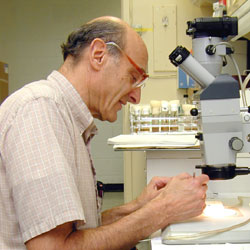| |
| |
| Howard A. Nash, M.D., Ph.D., Senior Investigator |
 |
Dr. Nash received his M.D and Ph.D. degrees from the University of Chicago, where he worked on ionic interactions of membrane phospholipids. Following a pediatric internship he joined NIMH, first as a Research Fellow and subsequently as an Investigator in the Laboratory of Neurochemistry. In 1984 Dr. Nash joined the Laboratory of Molecular Biology and continued his studies of the protein-DNA interactions that govern site-specific genetic recombination. He was elected to the American Academy of Arts and Sciences in 1989 and to the National Academy of Sciences in 1990. In recent years Dr. Nash's principal interest has been the use of genetics in the fruit fly, Drosophila melanogaster, to investigate mechanisms and consequences of general anesthesia.
|

|
Staff:
- Debasmita Alone, Ph.D., Postdoctoral Fellow aloned@mail.nih.gov
- Jennifer Day, B.S., Post baccalaureate Fellow, (301) 402-4505 dayje@mail.nih.gov
- Dongyu Guo, Ph.D., Research Fellow, (301) 402-0032 guod@mail.nih.gov
- David Sandstrom, Ph.D., Staff Scientist, (301) 402-3242 sandstrd@mail.nih.gov
- Shobi Veleri, Ph.D., Visiting Fellow, (301) 435-5876 veleris@mail.nih.gov
Research Interests:
The term arousal refers to the state of neural excitability that governs an organism's ability to interact with its environment. As such, it is the substrate upon which higher functions (like memory and coordinated movement) are built. Volatile general anesthetics disrupt all these complex processes and are believed to do so by depressing neural excitability. Thus, in addition to their value in the clinic, these poorly understood drugs provide a window into the neurobiology of arousal. Mutations that influence the effectiveness of anesthetics should identify genes that are important for arousal and the ways it can be undermined.
To enable an unbiased approach to finding such genes, we study anesthesia in the fruit fly. We previously showed that Drosophila and vertebrates have similar sensitivities to volatile agents, suggesting that their molecular targets are conserved. We also found that some neural circuits function quite well under concentrations of anesthetic that render the fly immobile. So, just as in vertebrates, the Drosophila nervous system appears to have elements with differential sensitivity to volatiles. These facts convince us that genes identified in Drosophila will be informative about arousal and anesthesia in higher organisms.
Recent highlights from our work include: 1) The gene for an unusual ion channel has profound and distinctive effects on anesthesia in Drosophila. Inactivation of this channel in a distantly related organism produces the same anesthetic effects, implying an intimate connection with arousal. 2) A second gene interacts genetically with the channel gene. Although the product of this gene lacks obvious motifs, it is strongly conserved, plays a vital role in the function of the channel, and interacts physically with it. 3) Electrophysiological assays reveal that anesthetics depress the excitability of larval motorneurons. Modeling studies of this simple system implicate a specific class of anesthetic target. 4) Volatiles produce a specific change in the response of the fly eye to a flash of light, a change reflecting the loss of a newly discovered pathway for feedback signaling from the brain to the eye.
|
Selected Recent Publications:
Humphrey, J., Hamming, K.,Thacker, C., Scott, R., Sedensky, M., Snutch, T., Morgan, P., and Nash, H. (2007) A Putative Cation Channel and Its Novel Regulator: Cross-Species Conservation of Effects on General Anesthesia, Curr. Biol. 17, 624-629.
Rajaram, S., Scott, R.L. and Nash, H.A. (2005) Retrgrade signaling from the brain to the retina modulates the termination of the light response in Drosophila, PNAS 102, 17840-17845.
Sandstrom, D.J. (2004) Isoflurane depresses glutamate release by reducing neuronal excitability at the Drosophila neuromuscular junction, J. Physiol. 558, 489-502.
Nash, H. (2002) In vivo genetics of anesthetic action, Britsh Journal of Anesthesia 89, 143-155.
Contact Information:
Dr. Howard A. Nash
Laboratory of Molecular Biology, NIMH
Porter Neuroscience Research Center
Building 35, 1B-1002
35 Convent Dr, MSC 3736
Bethesda, MD 20892-3736
Telephone: (301) 402-1041 (office),
(301) 402-0245 (fax)
Email: howardnash@mail.nih.gov
|
|















